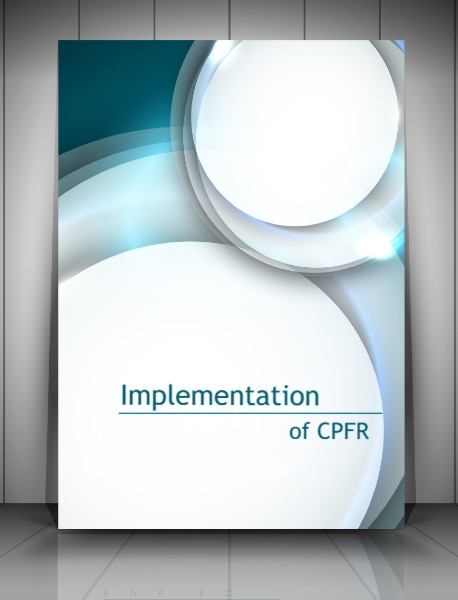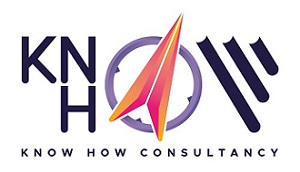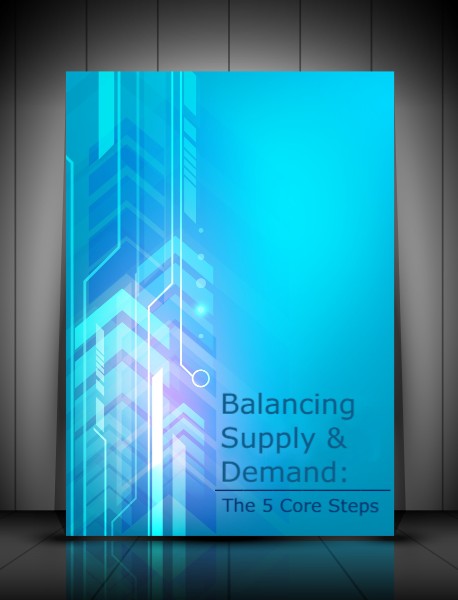
Implementation of CPFR
Collaborative Planning, Forecasting and Replenishment
Collaborative Planning, Forecasting and Replenishment (CPFR) is known as business practice that combines the operations of partners in terms of planning and the fulfillment of customer demand. In essence, CPFR plays a bridge role among partners’ sales and marketing operations to enhance product availability and to reduce inventory and delivery costs.
The objectives of CPFR are to;* Provide better supply-demand coordination through an effective information sharing* Manage processes based on partners’ exceptions, and* Meet end customers’ needs with a strong collaboration, which is organised well and lacking in restrictions
The history of CPFR dates back to the 1990s, when Wal-Mart and Warner-Lambert in the USA incorporated three sub-stages of planning, forecasting and replenishment in a joint project. The CPFR framework appeals to buyer-seller relations in multiple industries, such as retail, textiles, pharmaceutical, FMCG and food & beverages.
CPFR is an effective practice for partners to reduce inventory costs and the waste of consumer goods over long-term partnerships*. The CPFR aspect consists of the three prime processes of planning, forecasting and replenishment.
These processes constitute four important activities to improve the collaborative performance of partners (e.g. manufacturer – retailer):
- Strategy & Planning: Identify baseline rules for collaboration, and select product or product-groups merchandised by developing a joint business plan for a particular period
- Demand & Supply Management: Share Point-of-Sales (POS) data and additional sources to fulfill the forecasting and shipment requirements over the period
- Execution: Set orders, share delivery plans and consider the number of products in stock and on retail shelves. Then, record sales and make payment
- Analysis: Track the joint business plan in comparison with the execution progress made. Then, aggregate the results to measure performance parameters. Accordingly, share perceptions to improve the previously developed plan for continuous improvement in collaboration
CPFR Model – Manufacturer and retailer tasks:
Steps of CPFR:
The CPFR processes of planning, forecasting and replenishment link with each other, and each process needs to be adopted by partners to achieve the objectives of CPFR. This achievement relies on the nine consecutive steps of CPFR, which are summarized below;
STEP 1: Develop a collaboration agreement
- Develop CPFR mission statement: Establish a common rationale for cooperation, trust and availability of sources
- Determine CPFR goals and objectives: Identify attainable objectives and tasks that require agreement to measure performance. Define associated business activities and overall criteria connected with purchasing exceptions and order forecasting
- Discuss competencies, resources and systems: Show willingness and determination for required competencies, resources and systems to contribute to the CPFR process
- Define collaboration points and responsible business functions: Identify the extent of collaboration and responsibilities for both sides
- Determine information sharing needs: Clarify the types of information that are required for collaboration. Define how frequently and in which way information sharing will be conducted. Inform the partner company about how long a response time is acceptable before the request for information, and what forecasting methods are the base of forecasting
- Define service and ordering commitment: Structure the order and delivery commitments which need to be measured mutually to generate firm orders
- Determine resource involvement and commitments: Reciprocally identify sources that will be available through the CPFR processes (e.g. time and number of employees devoted to collaboration). Have an agreement on the ways of improving processes continuously
- Resolve differences between partners in the CPFR processes: Consult pre-established rules to solve disagreements and differences
- Regularly review cycle for CPFR agreement: Assess the process on a regular basis and evaluate success of the collaboration
- Publish front-end agreement: Initiate combined agreements. Update objectives and / or benchmark criteria for new demand and improvement, if required
STEP 2: Create a joint business plan
- Engage corporate strategies in a single business plan
- Consider the experience of category management and business planning to identify roles and objectives in collaboration
- Regard the requirements of continuous product based information exchange (e.g. minimum order, required lead-time for orders and order frequency)
Note: It should not be forgotten that partners need to follow the same vision to underpin their collaboration both internally and externally, where having a different organisational culture is likely to harm their agreement on a single business plan. Partners are likely to confront difficulties connected with building trust and commitment to each other, which in turn prevent them from proceeding with their agreements in CPFR. Building trust and long-standing collaborations relies upon their effective information sharing and continuous willingness given to build a positive memory / experience in the partner’s mind.
STEP 3: Create sales forecasts
- Employ POS data and retailer’s promotional plan to generate sales forecasts, in which using these information sources enhances the reliability of forecasts
STEP 4: Identify exceptions for sales forecasts
- Define products that were accepted as exceptions to sales forecasts to have an agreement on forecasts. It is important to identify exception criteria for each product in STEP 1
STEP 5: Resolve / collaborate on exception items
- Jointly identify exceptions in an effective time period for stronger forecasts
STEP 6: Create order forecasts
- Link the POS data of the retailer to the manufacturer’s inventory strategy for separately estimated order forecasts. Order quantity needs to be estimated based on “inventory target per product” and “the destination of product”
- Respond to the questions of “how much advance notice is necessary to transport the product to its destination? and does the order information reflect temporal differences?”
- Apply short-term forecasts for actual orders, and long-term forecasts for tracking the business plan which was developed jointly
STEP 7: Identify exceptions for order forecasts
- Identify the products entailing exceptions between partners to ease agreement on a single order forecast
STEP 8: Resolve / collaborate on exception items
- Commonly identify and clarify exceptions with efficient communication in a timely manner
- Reflect potential changes to forecast* Enhance the speed of information sharing to make timely decisions for a reliable order forecast
STEP 9: Generate Order
- Generate order forecast as the actual order of the retailer
- Order generation can be managed by either retailer or manufacturer
- Managing the process of order generation depends on partners’ forecasting skills, available information and access to information over appropriate IT systems
For further information about CPFR, I can suggest making use of these sources;
- Crum, C. and Palmatier, G.E. (2003) Demand Management Best Practices: Process, Principles and Collaboration, J.Ross Publishing, USA, Florida.
- ECR Europe (2002) European CPFR Insights, Accenture & Efficient Consumer Response (ECR), Brussels.
- Ireland, R.K. and Crum, C. (2005) Supply Chain Collaboration (Integrated business management series), J. Ross Pub., Florida, USA.
- Siefert, D. (2003) Collaborative Planning, Forecasting, and Replenishment: How to Create a Supply Chain Advantage, AMACOM Pub., New York, USA.
- VICS (2004) Overview: Collaborative Planning, Forecasting & Replenishment (CPFR®), Voluntary Interindustry Commerce Standards (VICS), USA.




